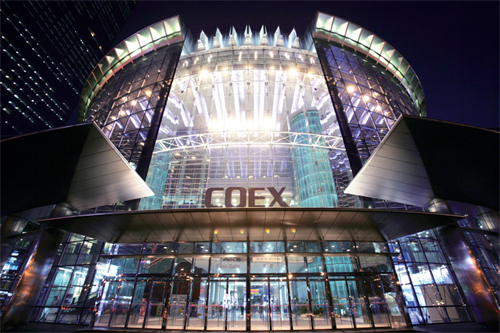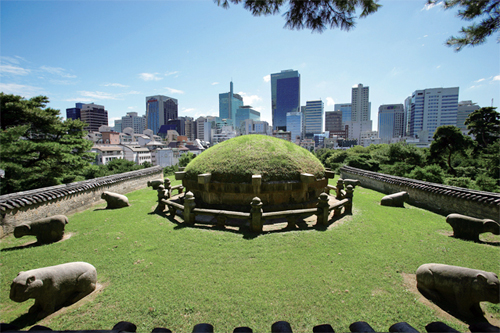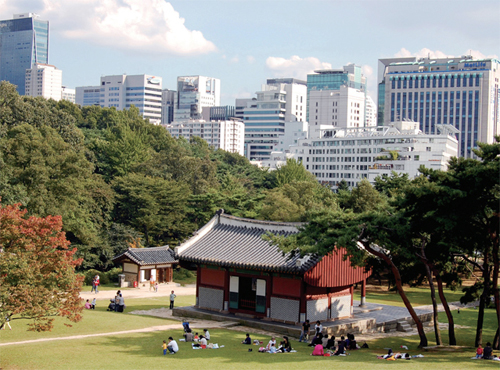Old and New Thrive at Samseong-dong
Thirty-one seconds into the record-breaking music video for “Gangnam Style,” rapper PSY does his signature horse-riding dance in front of a sleek glass-paneled building. A second later, the entire upper half of the glossy façade comes into view, dwarfing PSY and his still energetic galloping. For those familiar with the landscape of the Gangnam district, even these brief two seconds is enough to recognize the steep staircase-like slope of the tower behind PSY. The Trade Tower, as it is formally called, is one of the tallest buildings in Korea and a prominent landmark of the Gangnam neighborhood known as Samseong-dong.

The COEX Convention & Exhibition Center in Samseong-dong, Seoul stands as part of a complex known as the World Trade Center Seoul. COEX has hosted international events including the 2010 G20 Seoul Summit and the 2012 Nuclear Security Summit (photo courtesy of Gangnam District Office). True to Samseong-dong’s reputation as a center for business and international trade, the Trade Tower stands together with the ASEM Tower, the COEX Convention & Exhibition Center, and COEX InterContinental Seoul in a complex known collectively as the World Trade Center Seoul. The site has often doubled as a venue for such high-profile events as the 2010 G20 Seoul Summit and the 2012 Nuclear Security Summit, and all of this less than a 20-minute walk from the Han River.
COEX [Exit 5 or 6, Samseong Station, Subway Line 2]
For a proper experience of Samseong-dong and COEX in particular, it is necessary to go underground. COEX Mall, the largest underground shopping mall in Asia, stretches out for over 85,000 square meters directly below the Trade Center complex. With more than 260 shops and restaurants as well as a 16-screen multiplex, a museum dedicated to kimchi, and Korea’s second largest aquarium (recently dethroned by the Yeosu Expo aquarium), COEX Mall draws crowds all year round. Young people especially seem to enjoy frequenting this vast subterranean playground, chatting and laughing up and down the long hallways or thawing from the early winter freeze in one of the mall’s many cafés.
Bandi & Luni’s Bookstore, not far from the mall’s main entrance, is a favorite first stop for locals as well as foreign visitors. The shop carries over 150,000 books, including a wide selection of foreign books in English, Chinese, Japanese, Russian, Spanish, and more. From periodicals and magazines to graphic novels, travel guides, Korean language textbooks, and easy Hansik recipe books, there is something for every would-be bookworm. The entertainment section offers the latest CDs and DVDs in addition to various digital accessories, and the stationery and paper goods section stocks a dizzying array of colorful, character-inspired notebooks, pencils, and other collectibles.

A diver dressed in a Santa Claus outfit feeds sardines at the COEX Aquarium in Samseong-dong, Seoul during the holiday season (photo: Yonhap News)
Another highlight of the COEX mall is the COEX Aquarium, which currently houses over 40,000 fish and other marine wildlife representing a total of 650 species. Visitors can walk through twelve different sections, including the Ocean Kingdom where ocean dwellers such as sharks, stingrays, and turtles make their home in over 2,500 tons of seawater. A glass tunnel layout enhances the feeling of being on an underwater journey. Seals and South American penguins also number among the aquarium’s more unique inhabitants, together with manatees, sharks, and otters. As feeding takes place regularly during visiting hours, it isn’t uncommon to see trainers in scuba gear swimming alongside the various fish.
Located next to the aquarium, the bright neon lights that decorate Megabox Cineplex COEX are hard to miss. When the theater opened in 2000 as the first branch of the Megabox cinema chain, it was the largest multiplex in Asia and recorded over a million visitors within three months of opening. Today, the multi-floor cinema boasts a 4D theater in addition to its regular screens and regularly hosts film premieres as well as annual European and Japanese film festivals. Matinee showings begin as early as 8 a.m. and most final showings start well past midnight, providing a variety of options. But as large crowds on the weekends are a given, most moviegoers opt to take advantage of the convenient online reservation system and print their tickets from the automated machines onsite.

Megabox Cineplex COEX is a 16-screen theater in the COEX underground shopping mall (photo courtesy of Gangnam District Office)
For those who enjoy live entertainment, COEX Artium is located just outside the mall entrance. With over 800 seats, the performance theater holds various musicals and plays throughout the year. Currently playing is Legally Blonde: The Musical, the Korean adaptation of the popular Broadway production and a recent topic of local interest following the casting of Jessica from Girls’ Generation and Jung Eun-ji of A Pink in the lead roles. The building’s glass design and unique shape (which resembles a gat, or traditional Korean hat) make it easy to find.
Seonjeongneung Royal Tombs [Exit 8, Seolleung Station, Line 2 or the Bundang Line]
One subway stop or a five-minute drive from the subterranean bustle of COEX and glass and steel office buildings sits an unexpected sight. The Seonjeongneung Royal Tombs are three of 40 royal tombs from the Joseon Kingdom (1392-1910) that have together received the UNESCO World Heritage designation. As sites where not only the physical bodies of the deceased but also their memories and spirits were housed and honored, the burial sites of the Joseon monarchs were selected with great care. Traditionally, they were placed in auspicious locations where they could be protected by hills and face south toward water, ideally with mountain ridges visible in the distance.

The Seonjeongneung Royal Tombs in the Samseong-dong neighborhood of Seoul house three of 40 royal tombs
from the Joseon Kingdom that are scattered in 18 locations in Korea (photo courtesy of Gangnam District Office)
Nestled in a quiet, wooded park that is surprisingly peaceful for being located in the heart of busy Gangnam, the Seonjeongneung Royal Tombs and their surroundings have a beauty about them that suggest the importance of the royal burial customs. The Seonjeongneung Royal Tombs consist of Seolleung and Jeongneung. Seolleung is the burial site of King Seongjong (1457-1494), the ninth king of Joseon, and his second wife Queen Jeonghyeon (1462-1530). Jeongneung is where their son King Jungjong (1488-1544), the eleventh king of Joseon, is buried. While placed together and collectively called Seolleung, the king and queen’s tombs sit apart. King Seongjong’s tomb sits at the western end of the park, closest to its entrance, where a red-spiked gate known as hongsalmun indicates sacred grounds. In accordance with custom, the royal burial mound is surrounded by a stone fence and stone sculptures of civilian and military vassals and their horses. Just below the tomb area is Jeongjagak, a T-shaped wooden shrine where sacrificial rites were offered in honor of the king’s spirit.

The Samseong-dong neighborhood of Seoul is part of the Gangnam district made familiar by rapper PSY and his hit song “Gangnam Style.” One of the unique charms of Samseong-dong is its blend of old and new. Pictured is the view of the surrounding urban landcsape from the Seonjeongneung Royal Tombs (photo courtesy of Gangnam District Office). The tomb of Queen Jeonghyeon sits in the middle of the park, to the east of her husband’s. The queen is famous for her interest in Buddhism and her contribution to refurbishing the nearby Bongeunsa Temple.
Jeongneung, located at the easternmost part of the park, is the lowest-lying of the three tombs in terms of topography and thus requires special care during floods. King Jungjong’s tomb is one of three royal tombs where the king is buried alone. Having succeeded to the throne in the aftermath of a coup, King Jungjong is remembered as much for his efforts to introduce government reforms as for the opposition and factional infighting that thwarted their success. He is also known for having appointed as one of his personal doctors Jang Geum, the famous female royal physician whose story provided the inspiration for one of Korea’s most popular TV dramas.
